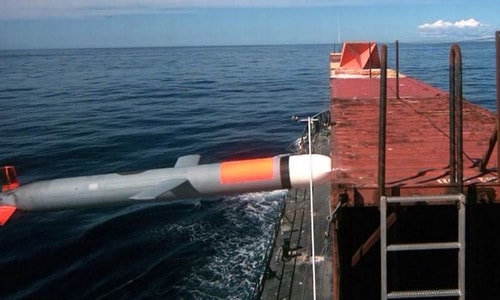The US wants to turn Tomahawk missiles into anti-ship killers
The Tomahawk Block IV version promises to have the ability to attack warships at long range, instead of just aiming at ground targets as it does now.
The US Navy tested the Tomahawk anti-ship missile.
The US Navy and Raytheon are set to sign a contract to integrate new sensors into the BGM-109 Tomahawk cruise missile, turning it into a ship-killer. The Tomahawk Block IV variant promises to be a game-changer at sea against rivals like Russia and China, according to USNI.
According to military expert Alex Lockie, the US Navy is far behind Russia and China in the field of anti-ship missiles. US cruisers and destroyers are equipped with long-range land-attack cruise missiles and advanced defense systems, but only carry outdated Harpoon anti-ship missiles that are far less powerful than their opponents.
China's YJ-18 and YJ-12 anti-ship missiles have a range of over 385 km and can fly at altitudes of just a few meters above sea level, while the anti-ship version of the Russian Klub missile has a range of up to 660 km. These weapons are all capable of reaching supersonic speeds when approaching their targets. Meanwhile, the US Harpoon missile has a range of only 125 km and a subsonic speed of 900 km/h.
Faced with this threat, the US Navy decided to upgrade Tomahawk missiles on destroyers and cruisers, allowing them to attack surface ships anddisrupting anti-access/area denial (A2/AD) systemsenemy.
"It will take two years of development to determine the seeker configuration for the missile, and another two years of production and testing for accuracy and reliability of the system," said Navy Captain Mark Johnson, PMA-280 Naval Air Systems Program manager.
 |
The Tomahawk anti-ship missile has a range of about 1,600 km. Photo: USNI. |
Raytheon and the Navy are still determining the type of sensors that will be integrated into the Tomahawk missile, but it is likely to be a multi-mode seeker that includes both passive and active sensors. These sensors will be integrated with other upgrades such as communication antennas, which will help the missile operate in environments with satellite interference. The warhead will also be improved to increase the level of damage to warships.
Testing of the anti-ship version of the Tomahawk will begin in 2019, with the missile expected to enter service in the early 2020s. "This is a feature that could change the game in the future without costing much. An anti-ship cruise missile with a range of 1,600 km can be equipped on our entire surface and submarine fleet," Mr. Bob Work, US Deputy Secretary of Defense, emphasized.
According to VNE
| RELATED NEWS |
|---|
